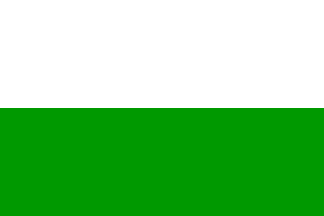 image by Ivan Sache, 14 July 2011
image by Ivan Sache, 14 July 2011
Last modified: 2024-03-02 by rob raeside
Keywords: education |
Links: FOTW homepage |
search |
disclaimer and copyright |
write us |
mirrors
See Also:
 image by Ivan Sache, 14 July 2011
image by Ivan Sache, 14 July 2011
Institución Educativa Distrital Robert F. Kennedy is located in El Luján
borough, part of the municipality of Engativá (Bogotá). The institute is named
for Robert Francis Kennedy (1925-1968), brother of President John F. Kennedy.
Bob Kennedy was Minister of Justice (1961-1964) and Senator of New York State
(from 1964 to his assassination).
The flag of the institute is vertically
divided red-white-blue (1:1:2), with the institute's emblem in the white stripe.
Red is a symbol of love and leadership, of esteem for oneself and the others, of
patriotic dedication, and of love for God. White is a symbol of peace and social
interaction. Blue is a symbol of the ocean of science and knowledge.
The
emblem of the institute is made of two circles. The outer circle represents the
word we live in, while the inner circle represents the institute. Between the
two circles, the words "COMMUNICACIÓN LIDERAZGO CONVIVENCIA" (Communication
Leadership Social Interaction) are the axes of the education project. The flame
represents the sports events organized at the institute and social interactions.
The book represents the communication process and knowledge. The initials "RFK",
for "Robert Francis Kennedy" are placed in the middle of the emblem.
http://rfk2009.es.tl/Nuestro-Cole.htm - Institute's website
http://redsocialrfkjm.bligoo.com/dia-del-trabajo - Photo of the flag
Ivan Sache,
14 July 2011
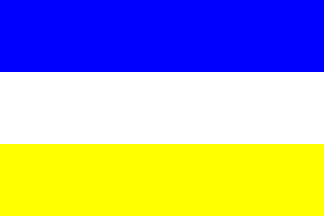 image by Ivan Sache,
6 July 2014
image by Ivan Sache,
6 July 2014
Colegio Roberto Garcia Peña was established in Giron (Santander Department)
by Decree No. 51 of 17 February 1994. The institute is named for the journalist
Roberto García Peña (1910-1993), director of "El Tiempo" from 1949 to 1981.
The flag of the institute is horizontally divided blue-white-yellow. Blue is
a symbol of historical projection by the institute. White is a symbol of hope
and purity. Yellow is a symbol of the people's idiosyncrasy.
http://ingridpaolamejia.wordpress.com/2013/11/01/bandera-del-colegio-roberto-garcia-pena
- Ingrid Paola Mejia's blog
Ivan Sache, 6 July 2014
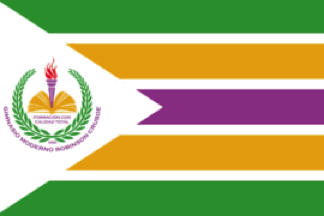 image by Ivan Sache, 1
January 2021
image by Ivan Sache, 1
January 2021
Gimnasio Moderno Robinson Crusoe was established in 1995 in Soacha
(Cundinamarca).
The flag of Gimnasio Moderno Robinson Crusoe is
horizontally divided green-ocher-purple-ocher-green, the stripes being separated
from each other by a thin white fimbriation, with a white triangle placed along
the hoist and charged with the school's emblem.
http://robinsoncrusoe.edu.co/portal/simbolos
School website
Ivan Sache,
1 January 2021
 image by Ivan Sache,
20 July 2014
image by Ivan Sache,
20 July 2014
Colegio Rodolfo Llinás is located in Desquebradas (Risaralda Department). The
institute is named for the neuroscientist Rodolfo Llinás Riascos (b. 1934),
currently Professor at the New York University School of Medicine, and author of
the best-seller "I of the vortex: from neurons to self" (MIT Press, 2002),
prefaced by his friend Gabriel García Márquez (1927-2014, awarded the 1982 Nobel
Prize in Literature).
The flag of the institute is horizontally divided
gray-white with the institute's emblem in the middle. Gray, also the colour of
the student's uniform, is a symbol of balance, stability and incentive to
creativity. White is a symbol of purity, innocence, optimism and concentration.
The emblem of the institute is made of a gray shield charged with:
- two
hands holding a globe inscribed with "VALORES" [Values];
- the representation
of an atom, a symbol of knowledge;
- the portrait of Dr. Rodolfo Llinás, the
institute's namesake;
The scroll placed beneath the shield is inscribed with
the writing "CIENCIA Y TECNOLOGIA" (Science and Technology).
The emblem is
surrounded by a red circle inscribed with the institute's name and location
("R." stands here for "Risaralda"). Red is a symbol of passion, energy, force
and love.
http://www.colegiorodolfollinas.com/insignias.php - Institute's website
image by Ivan Sache,
20 July 2014
 image by Ivan Sache,
6 March 2017
image by Ivan Sache,
6 March 2017
Institución Educativa Rodolfo Llinas Riascol originates in Escuela 13 Mixta,
established in March 1969. in Baranquilla. In 1994, the institute was renamed
Centro de Educación Básica No. 36. The institute adopted its present name in
2005., for the neuroscientist Rodolfo Llinás Riascol (b. 1934), currently
Professor at the New York University School of Medicine, and author of the
bestseller "I of the vortex: from neurons to self" (MIT Press, 2002), prefaced
by his friend Gabriel García Márquez (1927-2014, awarded the 1982 Nobel Prize in
Literature).
http://rodolfollinasriascos.webnode.es - Institute's website
The flag
of the institute is divided blue-white by the ascending diagonal, with the
institute's emblem in the middle. Blue is a symbol of knowledge, cleverness,
faith, and truth. White is a symbol of security and purity.
The emblem of
the institute is made of a drop-shape shield with a blue background, symbolizing
the light of knowledge, surrounded in chief left by the flag of Colombia and
right by the flag of Baranquilla. The shield is charged with an open book and
diverse technological devices, symbolizing sources of knowledge.
http://rodolfollinasriascos.webnode.es/nuestro-colegio/simbolos -
Institute's website
Ivan Sache,
6 March 2017
 image by Ivan Sache, 28 September 2018
image by Ivan Sache, 28 September 2018
Colegio Rodrigo Lara Bonilla was established, as Colegio Distrital Candelaria
La Nueva, by Municipal Agreement No. 11, adopted on 25 February 1983. The school
was renamed to Colegio Distrital Rodrigo Lara Bonilla by Municipal Agreement No.
41, adopted on 12 June 1984. Institución Educativa Distrital Rodrigo Lara
Bonilla was established by Resolution No. 3,649 adopted on 15 November 2002.
http://www.colegiorodrigolarabonilla.edu.co/crlb/wp-content/uploads/2016/05/Manual-de-Convivencia-2015.pdf
Manual de Convivencia
The school is named for the layer Rodrigo Lara
Bonillo (1946-1984). Appointed Minister of Justice in August 1983, Lara obtained
the expelling of the the drug lord Pablo Escobar from the Congress and the
revocation of his US visa; he further revived criminal charges against the drug
lords. On 30 April 1984, Lara was murdered by two henchmen commissioned by
Escobar. The murder resulted in the war against organized crime, led by Lara's
successor, Enrique Parejo González.
The flag of Colegio Rodrigo Lara
Bonilla is horizontally divided green-white-yellow with the school's coat of
arms in the center.
http://www.colegiorodrigolarabonilla.edu.co/crlb/nuestro-colegio/imagen-institucional/
School website
Ivan Sache, 28 September 2018
 image by Ivan Sache, 19 December 2008
image by Ivan Sache, 19 December 2008
"Instituto de Educación Técnica Profesional de
Roldanillo" (INTEP) was created on 17 May 1979 (Decree No.
1093) in Roldanillo as "Instituto de Educación
Intermedia Profesional de Roldanillo". The institute was
reorganized and renamed "Instituto de Educación Técnica
Profesional de Roldanillo" on 26 April 1988 (Decree No. 758)
and its general statutes were approved by the Ministry of
National Education on 15 May 1989 (Decree No. 1027).
The flag of INTEP is shown graphically and described on the INTEP website.
The flag is vertically divided yellow-white-blue with the emblem
of INTEP in the middle, in dimensions 1.20 m x 1.50 m (that is,
with proportions 4:5).
Yellow is the colour of the nobleness and high value of
knowledge, and of the joy and honour characterizing all the
working activities in the institute.
White is the colour of light and the greatest symbol of union,
purity and nobleness conferred by study.
Blue is the colour of the sky over Roldanillo, and, more
generally the colour of heavens once clouds have dispersed; it
represents truth, justice, the deep gentleness of the university
members and loyalty to the spiritual values.
Placed on the symbolically strong white colour, the emblem of
INTEP unites the meanings of the yellow and blue colours.
The vertical display of the colours represent the continuous
increase of knowledge towards excellence. It also expresses the
infinite and the possible movement. The colours are arranged to
match the physiologic mechanism of visual perception.
Yellow, a warm colour, is placed in the left visual field and is
interpreted by the brain right hemisphere, in relation to
sensibility, imagination, intuition and creativity.
Blue, a cold colour, is placed in the right visual field and is
interpreted by the brain left hemisphere, in relation to
intelligence, rationality, science and language.
The vertical stripes are arranged according to an horizontal
gradient of colour temperature, from the warm yellow to the cold
blue, mitigated by the quite cold and still white. This colour
display is harmonic and balanced, both in time and space.
The emblem of INTEP is made of a shield surrounded by an elliptic
border.
The elliptic border is ornamental but mandatory, with a ratio of
6:5 between its greater and smaller axes. It represents the
trajectory of a celeste body moving around another on
an orbit prescribed by the Law of universal gravitation.
In the lower focus of the elliptic shield is placed the shaft and
capital of a Doric column. The lower part of the shaft is charged
with a scroll bearing the motto ot INTEP and its Latin
translation. A woman and a man stand on the column, rising their
arms to support the globe placed in the upper focus of the
ellipse. The column symbolizes the support and cohesion provided
by the past and shared traditions to people, represented by a
pair in a creative function, aimed at the free research of inner
and outer knowledge.
The central elements are surrounded by two golden branches of
olive symbolizing peace and the commitment of INTEP to keep and
preserve the natural environment with the help of science and
progress.
Yellow, used in the outline of the outer ellipse, in the olive
branches and in the scroll, represents the sun as a source of
vitality, loyalty to the commitments, the nobleness and high
value of knowledge, and the joy and honour characterizing all the
working activities in the institute.
Blue, used in the central figures, in the globe and the column,
is the colour of the sky over Roldanillo, and, more generally the
colour of heavens once clouds have dispersed; it represents
truth, justice, the deep gentleness of the university members and
loyalty to the spiritual values.
The motto is written on the scroll in relief, with letters
outlined in black, representing prudence, shyness and honesty.
The background of the shield is white, the colour of light and
the greatest symbol of union, purity and nobleness conferred by
study.
Ivan Sache, 19 December 2008
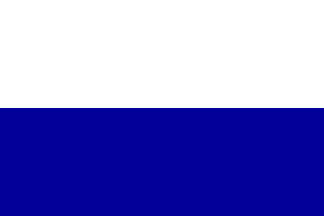 image by Ivan Sache, 13 October 2014
image by Ivan Sache, 13 October 2014
Institución Educativa Rosalía Suárez was established in the Belén borough,
part of the town of Medellín (Antioquia Department), by Resolution No. 16,385 of
27 November 2002, as the merger of Escuela Rosalía Suárez (est. in 1954 and
named by Ordinance No. 21 of 28 November 1959 for the mother of President of the
Republic Marco Fidel Suárez [1918-1921]), and Escuela Especial Municipal Belén.
The flag of the institute is described in the institute's Etiquette Guidebook as
horizontally divided white-blue. White is a symbol of peace, while blue is a
symbol of stability, deepness, loyalty, trust, knowledge, intelligence, faith,
truth, and eternity.
Source:
http://rosaliasuarez.edu.co/manual-de-conviencia/ - Institute's website
Ivan Sache, 13 October 2014

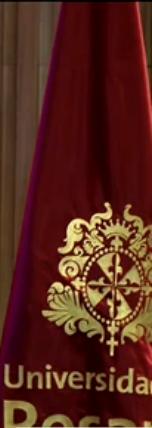 images located by Paul Bassinson, 1 July 2023 and Esteban Rivera, 25 October 2016
images located by Paul Bassinson, 1 July 2023 and Esteban Rivera, 25 October 2016
In a broadcast of TV news by CM& I spotted the flag for Universidad del
Rosario (Rosary's University).
Its full name is "Colegio Mayor de Nuestra
Señora del Rosario - Universidad del Rosario" (Major College of Our Lady of the
Rosary - Rosary's University). It was established on December 18, 1653 in Bogotá
Sources:
http://www.urosario.edu.co/Home/la-universidad/historia/ and
https://en.wikipedia.org/wiki/Del_Rosario_University
The flag
features the University's logo (http://www.urosario.edu.co/App_Themes/Ur_home/images/logo.png)
whose current version was adopted in 2011 (http://www.urosario.edu.co/Home/la-universidad/Adjuntos/2011.jpg).
The logo itself features the symbol of the
Order of Calatrava in maroon and white with the name in white. The flag is a
maroon horizontal flag with the symbol in white outline and golden letters. For
the evolution of its symbol please see:
http://www.urosario.edu.co/Home/la-universidad/El-escudo/
For
additional information go to Rosary's University (official website):
http://www.urosario.edu.co/
Esteban Rivera, 25 October 2016
The symbol is that of the Dominican Order,
but with colors changed.
Tomislav Todorovic, 25 October 2016
The University's official website states:
La Cruz de Calatrava es el símbolo de la Orden de Predicadores (Dominicos) (Order of Preachers, in Latin: Ordo Praedicatorum, postnominal abbreviation O.P.), also known as the Dominican Order, (official website: http://op.org/) fundada en 1215 por Domingo de Guzmán. Por pertenecer a dicha orden, el fundador del Colegio Mayor de Nuestra Señora del Rosario, fray Cristóbal de Torres, hereda al Rosario este emblema distintivo conformado por cuatro flores de lis adaptadas en blanco y negro. A partir de 1936, la Cruz de Calatrava se enmarca dentro de los lambrequines diseñados por Dionisio de Renart, autor de la Estatua del Fundador ubicada en el Patio Central del Claustro, reemplazando la simbología iconográfica dominica propuesta originalmente por el escultor.Source: http://www.urosario.edu.co/Home/la-universidad/El-escudo/
 image by Ivan Sache, 7 March 2017
image by Ivan Sache, 7 March 2017
Institución Educativa Rosedal, inaugurated on 26 March 2012, was established
in the El Educador borough, Cartagena de Indias, Bolívar Department. by
Corporación Educativa Minuto de Dios. Established in 1958 in the Minuto de Dios
borough by Father Rafael García Herreros Unda (1909-1992), the corporation
manages 24 educational institutes all over Colombia.
The flag of the
institute is horizontally divided blue-white-orange with the institute's emblem
in the center of the white stripe. The emblem features the skyline of Cartagena
and an open book, representing with the Gospel, charged with the letters "MD",
taken from the emblem of Corporación Educativa Minuto de Dios.
http://www.colegiosminutodedios.co/rosedalcartagena/index.php/quienes-somos/nosotros/simbolos
- Institute's website
Ivan Sache, 7 March 2017
 image by Ivan Sache, 12 August 2014
image by Ivan Sache, 12 August 2014
"Institución Educativa de Rozo" was founded in the
"corregimiento" of Rozo, Municipality of Palmira,
Department of Valle del Cauca, on 26 September 1979 (Decree No.
1953).
The flag of the institute, as shown graphically and described on
the website
of the institute, is horizontally divided white-green with a
thin golden border all around. The drawing shows the flag tied to
a staff with a peak-shaped finial and two golden tassels.
The flag was designed by María Mabel Castillo, current Director
of the institute. Green represents the natural environment of
Rozo, agriculture as the main source of income and the aspiration
to a better future. White represents purity, peace and liberty
provided in the institute. The golden border represents God's
light guiding us every day.
Ivan Sache, 29 January 2009
Institución Educativa de Rozo was established by Decree No. 1,953 of 26
September 1979 in the Rozo village, part of the municipality of Palmira (Valle
del Cauca Department).
The flag of the institute, designed by the Director, María Mabel Castillo, is
horizontally divided white-green., with a golden yellow border. White is a
symbol of purity, peace, and liberty. Green is a symbol of the natural
environment, of agriculture, and of hope. The golden yellow border represents
God's light.
Ivan Sache, 12 August 2014
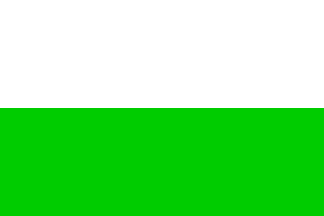 image by Ivan Sache, 24 November 2014
image by Ivan Sache, 24 November 2014
Institución Educativa Departamental Rufino Cuervo was established in
Chocontá (Cundinamarca Department) in 2006, as the merger of Colegio
Rufino Cuervo - originally established on 24 September 1924 by the
parish priest Agustin Gutierrez and the educationalist Miguel Cancelao
- and 12 rural schools - Aposentos, Guangüita Baja, Capellanía,
Mochila, Tablón, Tejar, Pozo Azul, Retiro de Indios, Retiro de
Blancos, Retiro Alto, Chingacio Bajo, and Chingacio Alto.
The institute is named for the lawyer, journalist and politician
Rufino Cuervo (1801-1853), President of the Supreme Court of Justice
and Vice President of Colombia.
The flag of the institute is horizontally divided white-green.
White is a symbol of peace and purity.
Green is a symbol of hope and of fertile fields.
Source:
http://iedrufinocuervochoconta.jimdo.com/mi-institucion/simbolos/ -
Institute's website
Ivan Sache, 24 November 2014